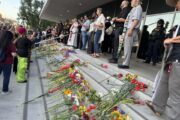At her old church, church leaders looked “at me like a sinner for plucking my eyebrows!” remembered Sonia. The church’s gender-specific regulations, imported from the congregation’s mother church in El Salvador, also affected Sonia’s life outside church. At work, she was uncharacteristically passive and shied away from leadership opportunities.
“How can I be oppressed at my church, but a leader at work?” she told me. “Coming from a church where women were oppressed, there was no way I could become a leader at my job.”
Sonia didn’t want a new religion, but she did want a Spanish-speaking church that spoke to her life as an Angeleno. She found Restauracion-LA. The Pentecostal church shows what it takes to successfully reinvent a congregation to appeal to a younger generation of worshippers.
At Restauracion-LA, Sonia could wear lipstick and sit next to her husband during the worship service, but most significantly, she saw women actively involved in prominent leadership roles. “As soon as I came here and I saw the leadership of Pastor Molina’s wife, Pastor Hanelory…something happened within me,” Sonia said. She credited her recent promotions at work to the model of leadership she experienced at her new church.
For a long time, though, Restauracion-LA was just like Sonia’s previous church. In 2008, pastors Rene and Hanelory Molina asked themselves a difficult question: “Are we going to be an El Salvadorian church located in Los Angeles or we will be a Los Angeles church built and founded by El Salvadorians?”
Restauracion-LA had grown from a few dozen members to 5,000 members primarily though people who, like the Molinas, were born in Central America. “For many years my wife and I did our ministry the way it was done in El Salvador,” Pastor Rene told me. “We had to think the way they thought, dress the way they dressed, sing the way they sang. We were almost like a photocopy of El Salvador in Los Angeles. But we began to see questions coming from the younger generation.”
If the church were to continue to flourish in the future, the pastors decided that it would be through members born primarily in Los Angeles, not Central America. Their strategy hinged on answering the questions arising from the “younger generation” and keeping them in the pews.
Keeping teenagers and Millennials in the pews is no small task. Recent findings show that less than half of Americans between the ages of 23 and 28 attend any sort of religious service at all. In Spanish-speaking churches like Restauracion-LA, many members in their twenties were born in different countries and very different cultural contexts than their parents, adding to the challenge now facing many churches.
To engage with this younger generation, Restauracion-LA leadership took an institutional inventory to identify the beliefs and practices that constitutes the essence of their Pentecostal Christianity. Their goal was to hold onto the essentials but be innovative around everything else, even if it those decisions meant straying from Central American Pentecostal culture.
“We were willing to change our structure if it enabled us to better meet the needs of people,” Molina said. “Our calling from God transcends culture. God doesn’t call us to import one culture to another, he calls us to establish his culture within the cultures.”
The rigid, gender-based requirements Restauracion-LA had inherited from their denomination in El Salvador were the first to go. From 2008 forward, men and women no longer were required to sit in gender-assigned sections in the sanctuary and the strict requirements regulating clothing, facial hair, use of cosmetics and hairstyles were relaxed.
As women took a more prominent role in teaching and worship, the Molinas braced themselves for the reaction. “We lost a lot of members,” Molina said. “The most difficult time was 7 years ago. We were a congregation of about 5,000 and we lost 1,200 people after the change. But we knew that there was no other way. I have no regrets and I would do it again.”
At a recent worship service and all-church picnic, I saw hundreds of teenagers and Millennials. Though Restauracion-LA’s membership is still below what it was pre-2008, the two events suggest that the church’s vision is resonating with an age group that is increasingly adverse to organized religion.
My colleague Richard Flory framed the data on the decreasing participation of Americans in religious institutions as “less a story of people ‘losing their religion’ than one of dissatisfaction with the institutional options available to them.” If his hunch is correct, other churches might want to look at Restauracion-LA as an example of a congregation that maintained its core theological concepts and practices, but was willing to radically transform itself as an institution to better meet the needs of the immediate community.
Photos Courtesy of Restauracion-LA
Andrew Johnson is a contributing fellow with the USC Center for Religion and Civic Culture.










